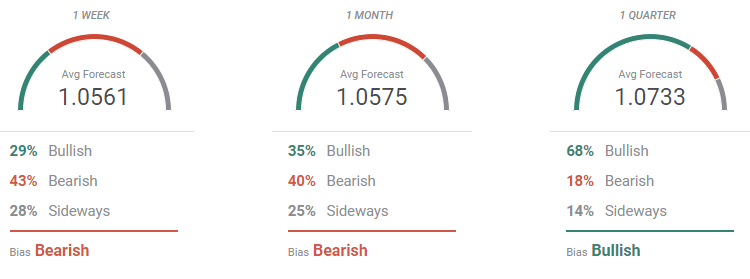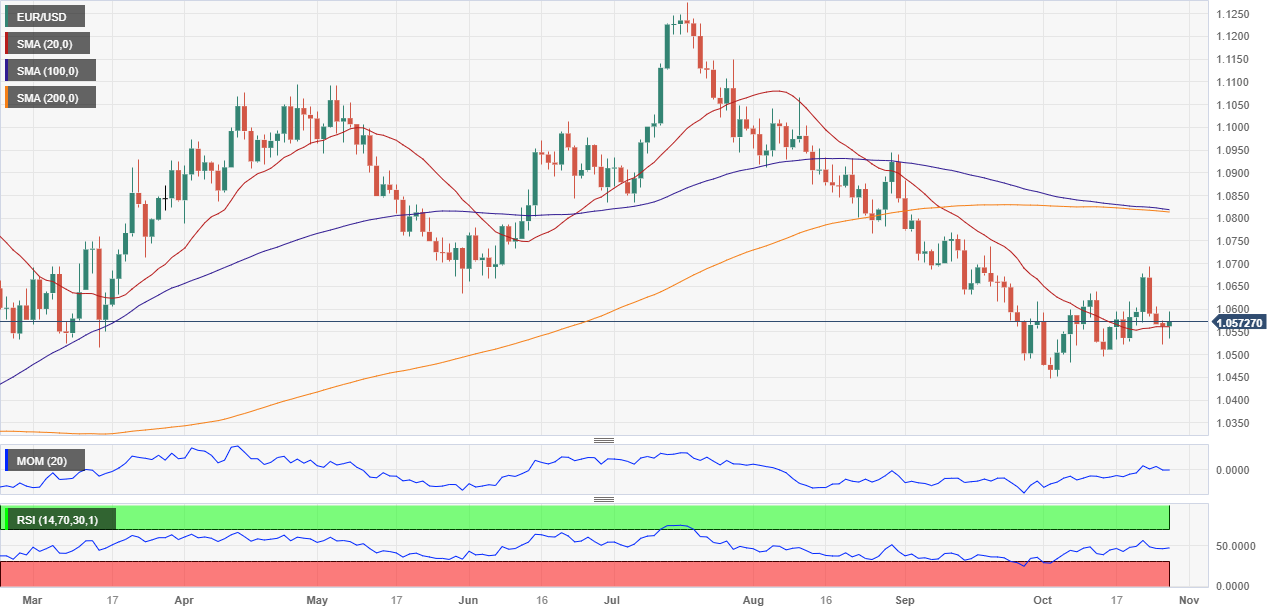- The European Central Bank put a halt to rate hikes, expressed concerns about growth.
- The US calendar will bring the Federal Reserve’s monetary policy decision and the Nonfarm Payrolls report.
- EUR/USD still unable to confirm an interim bottom, bulls need to reconquer 1.0700.
The EUR/USD pair attempted to extend its recovery this past week, peaking at 1.0693 but gave up ground and closed the week with modest losses at around 1.0570. The US Dollar started on the back foot, as the no escalation of the Israel-Hamas conflict brought some relief to financial markets. The Israeli ground incursion in the Gaza Strip continues to be delayed in the hopes the Palestinian group frees more hostages.
Uneven growth and central banks’ decisions
However, there were plenty of other news affecting financial markets. The Euro plummeted on Tuesday, as the S&P Global reports showed that the Euro Zone economic contraction steepened at the beginning of the last quarter of the year. S&P Global noted that “The German economy remained in contraction at the start of the fourth quarter,” adding that there are “ further signs of weakness in activity spilling over to the labor market.” The German Manufacturing PMI posted a modest improvement, printing at 40.7, while services output contracted to 48, a two-month low. For the Euro Zone, the economic downturn accelerated in the month, with the Composite PMI plummeting to 46.5, the lowest in almost three years.
Across the pond, data was far more encouraging. In the United States (US), business activity expanded in October by more than anticipated, according to S&P Global. The preliminary estimate of the Manufacturing PMI printed at 50, while the services index came in at 50.9. Finally, the Composite PMI was reported at 51, the highest in three months.
Meanwhile, the US Dollar partially benefited from a risk-off environment, as the earnings reports season brought mixed news, with big-tech names missing estimates and leading to sharp slides in global indexes. At the same time, government bond yields retreated from recent highs, cooling down markets a bit, but resumed their rallies ahead of the weekly close, also underpinning the USD.
The EUR/USD pair remained under selling pressure on Thursday following the European Central Bank (ECB) monetary policy decision. The ECB kept rates on hold as expected and following ten consecutive hikes. The accompanying statement and President Christine Lagarde’s press conference showed that European policymakers are concerned about the risks related to economic growth, which is still seen as skewed to the downside. They made it clear that inflation remains too high and that additional rate hikes are still on the table while rate cuts remain off of it.
Alongside the ECB announcement, the US released the preliminary estimate of the Q3 Gross Domestic Product (GDP). The economy grew at an annualized pace of 4.9% between July and September, much better than the previous 2.1% or the 4.2% expected. The upbeat figure was unable to trigger a directional movement in the US Dollar, as good news are not actually that good. The Federal Reserve (Fed) has long wished for below-trend growth to help bring inflation back towards the 2% target. Furthermore, unemployment data showed that the labor market remains quite tight, as Initial Jobless Claims for the week ended October 20 printed at 210K.
A pinch of optimism to end the week
Still, the USD retained the leadership. Finally on Friday, the US reported the September Personal Consumption Expenditures (PCE) Price Index, which was up 3.4% YoY, while the core PCE index, the Fed’s favorite inflation measure, rose by 3.7%, easing from the previous 3.8% rate. On a monthly basis, however, the PCE Price Index and the Core PCE Price Index increased by 0.4% and 0.3%, respectively. The figures initially backed demand for the USD but also pushed Wall Street off its early lows, partially offsetting USD strength.
Optimism was also backed by headlines indicating progress in negotiations about a ceasefire in the Middle East, mediated by Qatar.
By the end of the week, it is clear that uncertainty is high among market participants. Persistent demand for Gold, with XAU/USD nearing $2,000 a troy ounce, is one sign of it. On the one hand, the US economy has proved resilient, but that means rates will remain higher for longer. Easing inflation figures cooled down expectations for additional hikes. On the other hand, the European downturn continues with no bottom at sight.
Busy macroeconomic docket ahead
The upcoming week will offer multiple first-tier events that could clear doubts. Germany will release the preliminary estimates of the Q3 GDP and the October Harmonized Index of Consumer Prices (HICP) on Monday, while the EU will publish its respective figures on Tuesday.
The US will release the October ADP report on private job creation and the October ISM Manufacturing PMI on Wednesday, while the Fed will announce its decision on monetary policy later in the day. Finally on Friday, the country will unveil the October Nonfarm Payroll report and the October ISM Services PMI.

EUR/USD technical outlook
The weekly chart EUR/USD pair shows a bottom has not been confirmed yet. The pair retreated sharply after testing a bearish 100 Simple Moving Average (SMA), while the 20 SMA grinds marginally lower above it. At the same time, technical indicators have turned flat well below their midlines and after a modest upward correction.
In the daily chart, EUR/USD is technically neutral, although the risk remains skewed to the downside after the failed attempt to reconquer the 1.0700 threshold. The pair seesaws around a directionless 20 SMA, while the 100 and 200 SMAs converge around 1.0810. At the same time, technical indicators are stuck to their midlines without clear directional strength.
October 12 intraday high at 1.0639 is the immediate resistance level ahead of the 1.0700 threshold. An advance beyond it could lead to an upward extension towards the 1.0770 price zone. Near-term support comes at 1.0520, followed by the yearly low at 1.0447. A break below the latter should lead to a test of the 1.0320/40 price zone.
EUR/USD sentiment poll
The FXStreet Forecast Poll shows that EUR/USD will likely remain under pressure in the next few weeks, as sellers dominate the weekly and monthly perspectives, although with the pair seen on average holding above the 1.0500 threshold. For the quarterly view, bulls are a majority, increasing to 68% of the polled experts. On average, the pair is then seen at 1.0733.
The Overview chart reflects the ongoing uncertainty as the three moving averages lack clear directional strength. In the weekly view, most targets accumulate just above the current level, at around 1.0600, while the range widens to 1.0500/1.0700 in the monthly view. Finally, there’s not a clear long-term view as potential targets in the quarterly perspective are pretty evenly distributed. One thing that is worth noting is that the number of bets below 1.0500 is slowly increasing, skewing the risk to the downside.

